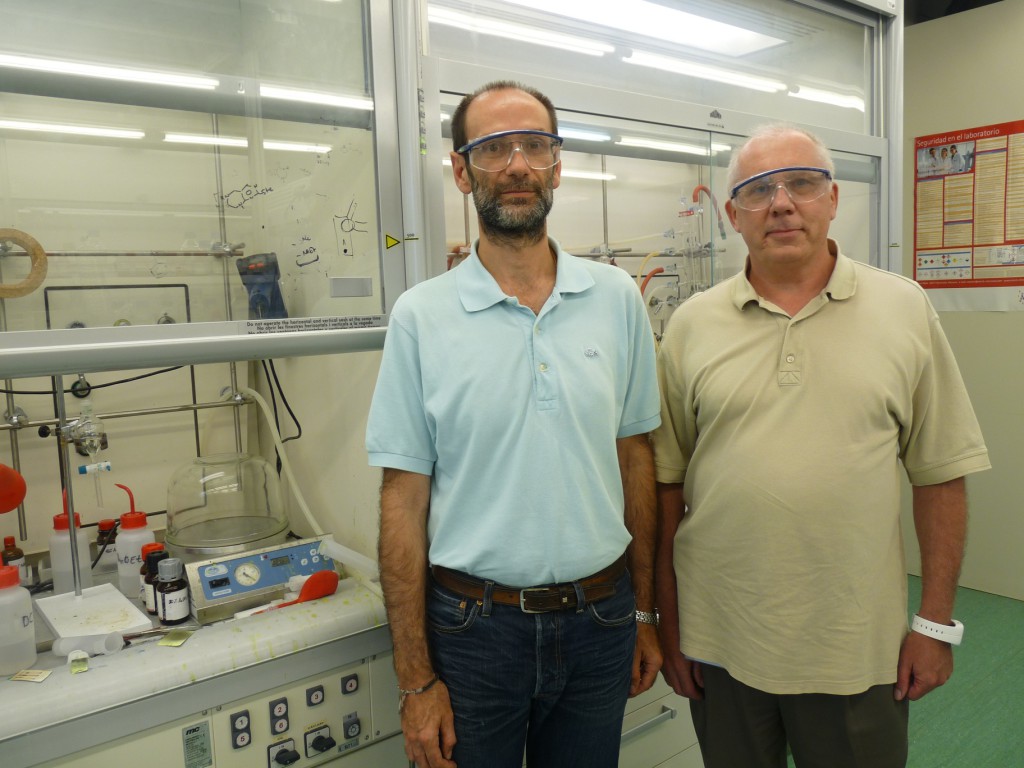09/07/2015
A hand-held sensor selective for benzene
The collaboration between the groups of Prof. Pau Ballester at ICIQ and Prof. Eduard Llobet at URV has allowed the development of a sensor highly selective for benzene in air with a lower limit of detection to the extent permitted by law. The work has been published in Advanced Functional Materials and selected for the back cover.

The collaboration between the groups of Prof. Pau Ballester at ICIQ and Prof. Eduard Llobet at URV has allowed the development of a sensor highly selective for benzene in air with a lower limit of detection to the extent permitted by law. The work has been published in Advanced Functional Materials and selected for the back cover.
Nowadays, there are several methods for the detection of traces of benzene, but they require pumping of the sample and a subsequent analysis using micro-chromatographic methods with a pre-concentration step before injecting in a detector. These methods are selective and reach sub-ppb level of benzene but they are limited in long time response, high power consumption and high cost. Industries and activities in which an occupational exposure to benzene is likely to occur would benefit from affordable, portable, highly sensitive and selective detectors able to run continuous measurements.
Sensor bencenoA good option in the design of receptors for aromatic compounds has been the employment of weak interactions, such as CH-π and π-π. It has previously been showed that quinoxaline bridged resorcin[4]arene is able to bind aromatic guests (benzene, toluene, etc.) in liquid, solid and gas phase. On the other hand, carbon nanotubes (CNTs) have attracted great interest due to their unique properties as sensing material for the detection of chemical molecules thanks to extreme sensitivity to their local chemical environment.
Having all this in mind, researchers at ICIQ and URV have developed a device with a receptor for aromatic compounds. They have prepared a new sensor based on multi wall carbon nanotubes (MWCNTs) oxygen plasma treated and decorated with gold nanoparticles whose surface was functionalized by quinoxaline-walled deep cavitands and they have found that the presence of benzene induces an increase of the resistance that allows the detection of this aromatic compound. The sensor has showed high response to benzene even in the presence of other similar aromatics with a theoretical limit of detection (LOD) of 600 ppt.
“The selectivity and sensibility of this device are unique and exceptional considering that they rely on the use of a single molecular receptor. On the contrary detecting volatile substances in biological systems usually involves the use of multiple receptors” -says Prof. Ballester.

Moreover, the sensing process is reversible at room temperature with the recovery of the resistance baseline upon air flushing, which is important for low power consumption. This makes it suitable for being integrated in hand-held portable analysers, wearable detectors and semi-passive radio frequency identification tags with sensing capabilities or in the nodes of wireless sensor networks with a wide range of potential applications in environmental monitoring, workplace safety or medical devices, among others. As Prof. Llobet says: “The same methodology could be applied to the development of specific sensors for other volatile compounds of interest in areas of air quality, personal protection, safety and medicine”.
An organic compound considered to carcinogenic
Benzene is a volatile organic compound and the most toxic among the BTEX (benzene, toluene, ethylbenzene and xylenes) compounds that can be found in the environment. Its levels can increase by emissions from the combustion of coal and oil, exhaust pipes, gasoline evaporation in gas stations or tobacco smoke. We are all exposed daily to small amounts of benzene, either outdoors, at work or at home. Benzene levels in the air are between 0,02 and 34 ppb. It has been recognised as human carcinogen by the US Environmental Protection Agency and the European Commission. Long-term exposure to relatively low concentrations of benzene over months or years leads to severe haemotoxic effects such as aplastic anaemia or acute non-lymphocytic leukaemia. In the last ten years, the permissible exposure limit has been lowered from 10 ppm to 100 ppb. It is obvious, therefore, that we need sensors that detect the presence of benzene and its concentration in order to ensure than the established limits are not exceeded.
Bibliographical reference: Deep Cavitand Self-Assembled on Au NPs-MWCNT as Highly Sensitive Benzene Sensing Interface P. Clément, S. Korom, C. Struzzi, E. J. Parra, C. Bittencourt, P. Ballester, E. Llobet. Adv. Funct. Mater., 2015, 25, 4011-4020
More news about: Eduard Llobet, EMaS, ICIQ, Pau Ballester
